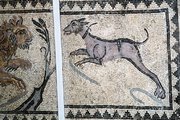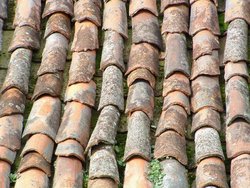Tile
|
|
- For the towns named Tile, see Tile, Somalia and Tile, Lebanon.
A tile is a small, manufactured piece of hard-wearing material such as clay or stone used for covering roofs, floors, and walls, or other objects such as tabletops. The word is derived from the French word tuile, which is, in turn, from the Latin word tegula, meaning a roof tile composed of baked clay. Less precisely, the modern term can refer to any sort of construction tile or similar object, such as rectangular counters used in playing games (see tile-based game).
| Contents |
Roof tiles
JapaneseRoofTiles.jpg
Roof tiles are designed mainly to keep out rain, and are traditionally made from locally available materials such as clay, slate, or wood (wooden tiles are called shingles). Modern materials such as concrete and plastic are also used. Some clay tiles have a waterproof glaze.
Because of their long history, a large number of shapes (or "profiles") of roof tiles have evolved. These include:
- Flat tiles - the simplest type, which are laid in regular overlapping rows. This profile is suitable for stone and wooden tiles, and most recently, solar cells.
- Roman tiles - flat in the middle, with a concave curve at one end at a convex curve at the other, to allow interlocking.
- Pantiles - with an S-shaped profile, allowing adjacent tiles to interlock. These result in a ridged pattern resembling a ploughed field.
- Mission or barrel tiles - semi-cylindrical tiles made by forming clay around a log. Laid in alternating columns of convex and concave tiles.
Roof tiles are 'hung' from the framework of a roof by fixing them with nails. The tiles are usually hung in parallel rows, with each row overlapping the row below it to exclude rainwater and to cover the nails that hold the row below.
Floor tiles
These are made of stone or clay. Clay tiles may be painted and glazed. Small tiles may be laid in patterns to form mosaics. The tiles are usually laid on a bed of sand, with cement sometimes added for extra strength. The gaps between the tiles are finally filled with a mortar mixture.
Wall tiles
BondStTilework_fx_wb.jpg
These are usually ceramic, but other materials such as mirrored glass or polished metal can be used. Wall tiles are usually glazed, and are often patterned by painting or embossing. Pictorial tiles, consisting of many tiles that the installer assembles like a jigsaw puzzle to form a single large picture, are available.
Modern wall tiles are fixed to a wall using a synthetic tile adhesive. The spaces between the tiles are filled with a fine cement called grout, which is rubbed smooth before it hardens.
Decorative tilework

Santarem_carfree.JPG
Decorative tilework typically takes the form of mosaic upon the walls, floor, or ceiling of a building. Although decorative tilework was known and extensively practiced in the ancient world (as evidenced in the magnificent mosaics of Pompeii and Herculaneum), it perhaps reached its greatest expression during the Islamic period.
Some places, notably Portugal, have a tradition of tilework on buildings that continues today.
In the United States, decorative tiles were in vogue, especially in southern California, in the 1920s and 1930s. Prominent among art tile makers during this period was Ernest A. Batchelder.
Islamic tilework
Perhaps because of the tenets of Moslem law (sharia) which disavow religious icons and images in favor of more abstract and universal representations of the divine, many consider decorative tilework to have reached a pinnacle of expression and detail during the Islamic period. Palaces, public buildings, and mosques were heavily decorated with dense, often massive mosaics and friezes of astonishing complexity. As both the influence and the extent of Islam spread during the Middle Ages this artistic tradition was carried along, finding expression from the gardens and courtyards of Málaga in Moorish Spain to the mosaics of the Hagia Sophia in Constantinople.
The mathematics of tiling
Certain shapes of tiles, most obviously rectangles, can be replicated to cover a surface with no gaps. These shapes are said to tessellate (from the Latin tessera, 'tile'). For detailled information on tilings see the tiling page.
History of tiles
Tiles were developed as a product of earthenware pottery, either as an alternative use for fragments of broken pottery (called potsherds) or as an independent invention. Tiles have been used in construction for at least 4000 years, by the Romans, Greeks, Babylonians, Phoenicians and many other cultures.

